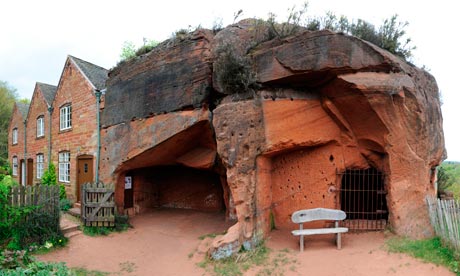
Distance 3 miles (4.8km)
Classification Easy
Duration 1 hour 30 minutes
Begins Kingsford Lane car park
OS grid reference SO840835
Walk in a nutshell
A good trek around the borders of Worcestershire and Staffordshire, taking in landscaped glades and ancient woodland, glorious views from an imposing sandstone ridge, the remains of an iron age hill fort, and Kinver's extraordinary carved rock houses. This is not a flat walk, so do bring good boots and expect a workout.
Why it's special
Hard though you might find it to believe, Britons only stopped living in caves in the 1950s when the last two families moved out of these 11 rock houses. Originally carved out of the soft sandstone ridge in around 1770, probably to provide space for employees at the Hyde Iron Works, they remain some of the most surprising buildings – if you can call them buildings – in the country.
One of the Holy Austin rock houses has been restored to show how its Victorian inhabitants would have lived. Another, in the Martindale Caves, now shows what life was like there in the 1930s. (Phone 01384 872553 for opening times.)
Keep your eyes peeled for
Life inside the rock houses can't have been much fun. You'll notice that each house has just one bedroom and one living area, with no running water, so all the families living in them would share an outdoor privy.
Recover afterwards
One of the rock houses has now been converted into a National Trust tearoom, serving homemade cakes, snacks and drinks. Otherwise, the Whittington is a lovely historic pub in Kinver, serving traditional drinks and pub food. For something more upmarket, try the Dunsley Hall hotel.
If it's tipping down
Stourbridge is a historic centre for glass-making and includes the Broadfield House Glass Museum , where you can watch hot glass being blown everyday except on Mondays and Tuesdays. Just slightly further away is Kidderminster, you'll find the Railway Museum which houses a large collection of train-related artefacts . Beyond that is Bewdley, where you'll find the Bewdley Museum which is full of family-oriented local history. Don't miss the interactive craft demonstrations including rope-, brick-, willow basket- and clay pipe-making .
How to get there
Stourbridge railway station is 5 miles away. From there the 228 bus goes hourly to Kinver.
Step by step
1 From the Gorse Covert car park on Kingsford Lane, head south and turn immediately right, keeping the boundary on your right, passing through an impressive landscaped beech glade. The path curves around to the left before dropping down through the more characteristic birch woodland. Keep the boundary on your right to join the public footpath overlooking Vale Head Farm and climbing up the hill until the public footpath drops down to Kingsford Lane.
2 Cross the road and turn right on to a permissive bridleway which runs parallel to the lane, passing an oak plantation on the right, an impressive line of aged oaks and an open space of heather. Follow the curve of the path to a surfaced vehicle track marking the county boundary and that of Kinver Edge and Kingsford Lane country park.
3 Turn left and follow this track up to the top of the edge, marked by a second line of large mature oaks, and the start of the Staffordshire Way.
4 Turn left here through the gateway and head north through a shady woodland and overgrown plantation along the ridge to emerge into the open heathland of Kinver Edge. Keeping the ridge on your left and the heathland on your right, you eventually enter the grazed area of an iron age fort with artificial ramparts forming two sides.
5 Staying on the Staffordshire Way leads to a set of steps down the west side of the edge of the fort, plunging back into the oak woodland and towards a T-junction. Follow the directions on the fingerpost and turn right down a sloping path to the rock houses, passing through a wide open sandy area.
6 After visiting the rock houses, head back to the sand patch and T-junction and continue straight on through the woodland, crossing the road to return to the car park.

